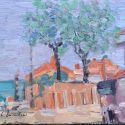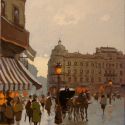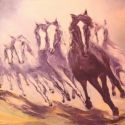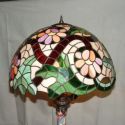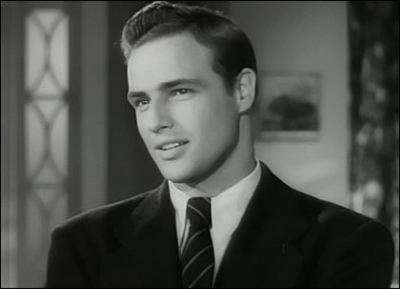
photo:
http://4.bp.blogspot.com/_s2BhR14qgt8/TKtL7zMN_-I/AAAAAAAAA1o/0t0KWok8AYc/s1600/tumblr_l227f1QMA51qbaigdo1_500.jpg
Biography
Youth and early acting career
Brando was born in Omaha, Nebraska. In 1935, when Brando was 11 years old, his parents, Marlon Brando Sr. and Dorothy Pennebaker Brando separated. His mother briefly took her three children to live with her mother in Santa Ana, California until 1937 when the parents reconciled and moved to Libertyville, Illinois, a village north-west of Chicago. The family were of primarily Dutch, Irish and English stock, although the family name originated in Germany (Brandau). Brando's mother was a kind and talented woman, although she suffered from alcoholism and was frequently absent in Brando's childhood. She was involved in local theater and helped a young Henry Fonda to begin his own acting career, and fuelled Brando's interest in stage acting. Brando was a gifted mimic from early childhood and developed a rare ability to absorb the tics and mannerisms of people he played and to display those traits dramatically while staying in character. His elder sister, Jocelyn Brando, was also an actress, albeit not of the same stature as Marlon.
Brando had a tumultuous childhood, in which he was expelled from several schools. His father was largely critical of his son, but encouraged him to seek his own direction. Brando left Illinois for New York City, where he studied at the American Theatre Wing Professional School, New School Dramatic Workshop, and the Actors' Studio. It was at the New School's Dramatic Workshop that he studied with Stella Adler and learned the revolutionary techniques of the Stanislavski System.
Marlon Brando in A Streetcar Named Desire, photographed by Carl Van Vechten, 1948
Brando used his Stanislavski System skills in summer-stock roles in Sayville, New York. His behavior got him kicked out of the cast of the New School's production in Sayville, but he was discovered in a locally produced play there and then made it to Broadway in the bittersweet drama, I Remember Mama, in 1944. Critics voted him "Broadway's Most Promising Actor" for his role as an anguished, paraplegic veteran in Truckline Café, although the play was a commercial failure. He achieved real stardom, however, as Stanley Kowalski in Tennessee Williams' play A Streetcar Named Desire in 1947, directed by Elia Kazan. Brando sought out that role, driving out to Provincetown, Massachusetts where Williams was spending the summer to audition for the part. Williams recalled that he opened the screen door and knew, instantly, that he had his Stanley Kowalski.
On the screen
Brando's first screen role was the bitter crippled veteran in The Men in 1950. True to his method, Brando spent a month in bed at a veterans' hospital to prepare for the role.
He made a much larger impression the following year when he brought his performance as Stanley Kowalski to the screen in Kazan's adaptation of "Streetcar" in 1951. He was nominated for an Academy Award for Best Actor for that role, and again in each of the next three years for his roles in Viva Zapata! in 1952, Julius Caesar in 1953 and On the Waterfront in 1954.
Brando finally won the Oscar for his role of Terry Malloy in On The Waterfront. Under Kazan's direction, and with a talented ensemble around him, Brando used his Stanislavski System training and improvisational skills. Brando claimed that he had improvised much of his dialogue with Rod Steiger in the famous, much-quoted scene ("I could have been a contender.") with him in the back of a taxicab (Kazan disputed this).
Brando followed that triumph by a variety of roles in the 1950s that defied expectations: as Sky Masterson in Guys and Dolls, where he managed to carry off a singing role; as Sakini, a Japanese interpreter for the U.S. Army in postwar Japan in The Teahouse of the August Moon; as an Air Force officer in Sayonara, and a Nazi officer in The Young Lions. While he won an Oscar nomination for his acting in Sayonara, his acting had lost much of its energy and direction by the end of the 1950s.
Brando's star sank even further in the 1960s as he turned in increasingly uninspired performances in Mutiny on the Bounty and several other forgettable films. Though even at this professional low point, Brando still managed to produce a few exceptional films; such as One-Eyed Jacks (1961), a western that would be the only film Brando would ever direct, Reflections in a Golden Eye (1967) portraying a repressed gay army officer, and Burn! (1969) which Brando would later claim as his personal favourite, although a commercial failure. Nonetheless, his career had gone into almost complete eclipse by the end of the decade thanks to his reputation as a difficult star and his record in overbudget or marginal movies.
The Godfather
Marlon Brando as Don Corleone in The Godfather, from Paramount Pictures via the Canadian Press
His performance as Vito Corleone in The Godfather in 1972 changed this. Director Francis Ford Coppola convinced Brando to submit to a "make-up" test, in which he (Brando) did his own makeup. Francis Ford Coppola was electrified by Brando's characterization as the head of a crime family, but had to fight the studio in order to cast him. Brando was voted the Academy Award for Best Actor for his intelligent performance; once again, he improvised important details that lent more humanity to what could otherwise have been a clichéd role.
Brando turned down the Academy Award, the second actor to refuse an Oscar (the first being George C. Scott for Patton.) Brando boycotted the award ceremony, sending little-known Native American actress Sacheen Littlefeather (nee Maria Cruz) to state his reasons, which were based on his objections to the depiction of Native Americans by Hollywood and television.
The actor followed with one of his greatest performances in Last Tango in Paris, but it was overshadowed by an uproar over the erotic nature of the Bernardo Bertolucci film. Despite the controversies which attended both the film and the man, the Academy once again nominated Brando for the Best Actor.
Late career
Brando as Jor-El in the first Superman movie.
His career afterwards was uneven: in addition to his iconic performance as Colonel Kurtz in Apocalypse Now, Brando also played Jor-El, Superman's father, in the first Superman movie—a role he agreed to only on condition that he did not have to read the script beforehand and his lines would be displayed somewhere offscreen. Other later performances, such as The Island of Dr. Moreau, earned him some of his most uncomplimentary reviews of his career. Despite announcing plans to retire—which he made good on for most of the 1980s—he subsequently gave interesting supporting performances in movies such as A Dry White Season (for which he was again nominated for an Oscar in 1989), The Freshman in 1990 and Don Juan DeMarco in 1995.
Off screen
It has been suggested that Christian Brando be merged into this article or section. (Discuss)
Along with his romances and marriages, Brando's crusades for civil rights, the Native American rights, and other political causes, kept him in the public eye throughout his career. He married actress Anna Kashfi in 1957, mistakenly believing her to be of Asian Indian descent when she was in fact from Wales and of Irish Catholic extraction (her real name was Joan O'Callaghan). O'Callaghan didn't discourage Brando's mistake; in fact, she dressed and made herself up as an Indian beauty after learning that Brando gravitated toward exotic women. They divorced in 1959, after having one son, Christian Brando together.
In 1960, Brando married Maria "Movita" Castaneda, a Mexican actress 7 years his senior who had appeared in the first Mutiny on the Bounty film in 1935, some 27 years before Brando's own version was released. A remake of Mutiny on the Bounty in 1962, with Brando as Fletcher Christian, seemed to bolster his reputation as a difficult star. He was blamed for a change in directors and a runaway budget though he disclaimed responsibility for either.
The "Bounty" experience affected Brando's life in a profound way: he fell in love with Tahiti and its people. He took a 99-year lease on part of an atoll island, Tetiaroa, which he intended to make part-environmental laboratory and part-resort. Tahitian beauty Tarita Teriipia, who had appeared in the film as Fletcher Christian's love interest, became his third wife after he and Castaneda were divorced. Teriipia became the mother of three of his children (one of whom died, see below). The hotel on Tetiaroa was eventually built; it went through many redesigns due to changes demanded by Brando over the years, but is now closed. A new hotel consisting of 30 deluxe villas is due to open in 2008.
In June 1973, Brando broke paparazzo Ron Galella's jaw. Brando's hand became infected as a result. In the following year, Galella wore a football helmet when snapping photos of Brando.
In his 1976 biography "The Only Contender" by Gary Carey, Brando was quoted as saying, "Like a large number of men, I, too, have had homosexual experiences, and I am not ashamed. I enjoyed all of them." Photographs circulate on the Internet that appear to confirm this. A 2006 book alleges affairs with Rock Hudson and Cary Grant.
An alleged long time lover of Brando's was the actor Wally Cox. Brando is quoted as saying: "If Wally had been a woman, I would have married him and we would have lived happily ever after." [1] After Cox died in 1973, Brando kept his ashes for 30 years, and they were eventually scattered with his own. Cox's third wife only discovered he possessed them after reading an interview in Time magazine where Brando is quoted as saying: "I have Wally's ashes in my house. I talk to him all the time." She wanted to sue, but her lawyers would not accept the case.[2]
All three of Brando's wives were pregnant when he married them. The number of children he had is still in dispute, although he recognized eleven children in his will; they were (ages as given in 2005):
by his marriage to actress Anna Kashfi:
Christian (47)
by his marriage to actress Movita Castaneda:
Miko (44)
Rebecca Brando Kotlinzky (39)
by his marriage to Tarita Teriipia:
Simon Teihotu (42) - the only inhabitant of Tetiaroa
Cheyenne (committed suicide in 1995 at the age of 25)
by adoption:
Petra Brando-Corval (33), daughter of Brando's assistant Caroline Barrett
Maimiti (29)
Raiatua (24)
by his maid Christina Maria Ruiz:
Nina Priscilla (15)
Myles Jonathan (13)
Timothy Gahan (11)
In May 1990, Brando's first son, Christian, shot and killed Dag Drollet, 26, the Tahitian lover of Christian's half-sister Cheyenne, at the family's hilltop home above Beverly Hills. Christian, 31, claimed the shooting was accidental.
After a heavily publicized trial, Christian was found guilty of voluntary manslaughter and use of a gun. He was sentenced to 10 years. Before the sentencing, Marlon Brando delivered an hour of rambling testimony in which he said he and his ex-wife had failed Christian. He commented softly to members of the Drollet family: "I'm sorry. ... If I could trade places with Dag, I would. I'm prepared for the consequences."
Afterward, Drollet's father said he thought Marlon Brando was acting and his son was "getting away with murder."
The tragedy was compounded in 1995, when Cheyenne, said to still be depressed over Drollet's death, committed suicide by hanging herself in Tahiti. She was only 25 years old.
Brando's notoriety, his family's troubled lives, his self-exile from Hollywood, and his obesity, unfortunately attracted more attention than his late acting career. He also earned a reputation for being difficult on the set, often unwilling or unable to memorize his lines and less interested in taking direction than in confronting the film director with odd and childish demands. On the other hand, most other actors found him generous, funny and supportive. Although more and more reclusive in his declining years, Brando was by nature a casual and friendly man. Occasionally, the public would observe the gargantuan Brando stop by Will Wright's ice cream parlor, enjoying his treat seated on two chairs he had pushed together.
The actor was a long-time close friend of the entertainer Michael Jackson and paid regular visits to his Neverland Ranch, resting there for weeks. Brando also participated in the singer's solo career 30th anniversary celebration concerts in 2001, as well as starring in his 15 minutes long music video "You Rock My World", the same year. The actor's son, Miko, was Jackson's bodyguard for several years, and is also a friend of the singer.
On July 1, 2004, at 6:30 p.m. local time, Brando died at the age of 80. The cause of his death was intentionally withheld, with his lawyer citing privacy concerns. It was later revealed that he died at UCLA Medical Center of lung failure brought on by pulmonary fibrosis. He had also been suffering from congestive heart failure and diabetes, which was causing his eyesight to fail, and had also recently been diagnosed with liver cancer.
Controversy
The infamous Playboy magazine interview of January 1979, Brando was charged with anti-Semitism in regard to his unfavorable opinion on Jewish influence in Hollywood. "You've seen every single race besmirched, but you never saw an unfavorable image of the Kike because the Jews were ever so watchful for that. They never allowed it to be shown on screen." Brando generally kept his views to himself and withdrew from the public eye in later life. Brando portrayed George Lincoln Rockwell, the American Nazi Party leader, in the Roots: The Next Generation episode in which Rockwell gave an interview to Alex Haley; ironically, also for Playboy.
Trivia
Brando in 1948
Despite his later obesity Brando would diet, run and lift weights to keep in shape in his early to mid career. He started to lift weights while in high school.
Turned down the title role in Lawrence of Arabia.
Turned down Butch Cassidy and the Sundance Kid in order to make Burn!.
He had eleven straight commercial disappointments between 1959's The Fugitive Kind till 1972's The Godfather and Last Tango in Paris.
Made "Top 10 stars of the year", 5 times. 1954, 1955, 1958, 1972, 1973.
When making Superman, Brando was paid $3.7 million, plus 16.86% of the gross. The film made $300 million worldwide, making his earnings $14 million for 12 days work.
Brando's height was always listed as 5'10". However, many people believe he was closer to 5'8", and in later films at least he was known to wear elevator shoes.
Brando was paid $1 million to appear briefly at the Michael Jackson 30th Anniversary concert a few days before the 9/11 terrorist attacks in 2001.
Brando is mentioned in the song "Pocahontas" by Neil Young, "China Girl" by David Bowie, "We Didn't Start the Fire" by Billy Joel, "Vogue" by Madonna, "Advertising Space" by Robbie Williams "Eyeless" by Slipknot and The Ballad of Michael Valentine by The Killers.
Frank Sinatra loathed the non-singing Brando for getting the starring role in Guys and Dolls, whereas Frank got a lesser part. Frank's nickname for the sometimes barely coherent Brando was "Mumbles."
Only made two television appearances in his career. 1979's Roots: The Next Generations for which he won an Emmy and in 1949 on "Actor's Studio" in the episode "I'm no Hero".
In a recent Channel 4 television poll voted for by his fellow actors, Brando was named the "World's Greatest Actor"
Filmography
DVD Cover of Brando's debut, the 1950 film The Men
The Men (1950)
A Streetcar Named Desire (1951)
Viva Zapata! (1952)
Julius Caesar (1953)
The Wild One (1953)
On the Waterfront (1954)
Desirée (1954)
Guys and Dolls (1955)
Operation Teahouse (1956) (short subject)
The Teahouse of the August Moon (1956)
Sayonara (1957)
The Young Lions (1958)
The Fugitive Kind (1959)
One-Eyed Jacks (1961) (also director)
Mutiny on the Bounty (1962)
The Ugly American (1963)
Bedtime Story (1964)
Morituri (1965)
The Chase (1966)
The Appaloosa (1966)
Meet Marlon Brando (1966) (short subject)
A Countess from Hong Kong (1967)
Reflections in a Golden Eye (1967)
Candy (1968)
The Night of the Following Day (1968)
Burn! (1969)
King: A Filmed Record... Montgomery to Memphis (1970) (documentary)
The Nightcomers (1972)
The Godfather (1972)
Last Tango in Paris (1972)
The Missouri Breaks (1976)
Raoni (1978) (documentary) (narrator)
Superman (1978)
Apocalypse Now (1979)
The Formula (1980)
A Dry White Season (1989)
The Freshman (1990)
Hearts of Darkness: A Filmmaker's Apocalypse (1991) (documentary)
Christopher Columbus: The Discovery (1992)
Don Juan DeMarco (1995)
The Island of Dr. Moreau (1996)
The Brave (1997)
Free Money (1998)
The Score (2001)
Upcoming:
Superman Returns (2006) (appears in archive footage as Jor-El)
Big Bug Man (2006) (voice)
Notes
^ Quoted in Brando Unzipped, Darwin Porter, 2006
^ Patricia Cox Shapiro, quoted in "The Wild One and the Mild One" by Robert W. Welkos, Los Angeles Times, 24 October 2004



